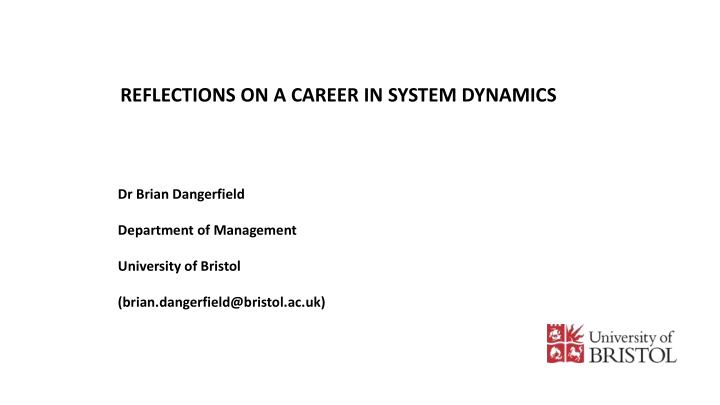



REFLECTIONS ON A CAREER IN SYSTEM DYNAMICS Dr Brian Dangerfield Department of Management University of Bristol (brian.dangerfield@bristol.ac.uk)
GENERAL OVERVIEW • Three main external projects • HIV/AIDS (1987 – 2001) [EU Concerted Action 1994 -1997] • Sarawak Economic Modelling project (2003 – 2005) • Construction Industry competitiveness [EPSRC project] (2005-2008)
HIV/AIDS RESEARCH Multinational Scenario Analysis Concerning Epidemiological, Social & Economic Impacts of HIV/AIDS on Society , 1994-97 Twenty teams from eleven nations were represented in this research coordinated by RIVM, Bilthoven, The Netherlands. No other team used SD: statistical epidemiologists & others using deterministic models based upon differential eqns Compare with situation now in modelling obesity and climate change
TWO IMPORTANT JOURNAL ARTICLES “Optimisation as a statistical estimation tool: An example in estimating the AIDS treatment -free incubation period distribution”, System Dynamics Review , 1999 Cited in : AIDS Patient Care & STDs (2015); New Journal of Physics (2010); International Journal of STD & AIDS (2005); Procs of the Royal Society – Biological Sciences (2002) “Model -based scenarios for the epidemiology of HIV/AIDS: the consequences of highly active antiretroviral therap y”, System Dynamics Review , 2001 Cited in : American Journal of Epidemiology (2016); Epidemiology & Infection (2015); AIDS Patient Care & STDs (2015); Current Opinion in HIV & AIDS (2010); International Journal of Electronic Healthcare (2009); Emerging Infectious Diseases (2006); Journal of Acquired Immune Deficiency Syndromes (2004 & 2006); American Journal of Public Health (2006); AIDS (2002); PLoS One (2013); PLoS Medicine (2012); Mathematical Biosciences & Engineering (2009); International Journal of STD & AIDS (2007)
SARAWAK: Economic Development Modelling (2003 – 2005)
Map of Borneo
SARAWAK: Economic Development Modelling • Contact was the State Planning Unit (SPU) in Kuching • Almost 2 years between the project first being mooted & the contract signed with U of Salford • They wanted to understand what SD was & what it could offer (knew a little about econometrics) • Great benefit in that two local academics were seconded to the SPU and acted as our ‘local champions’ • Approx first 2 visits included a comprehensive tour of Sarawak so as to experience the State and its economy ….. • When they realised that Vensim offered an easy-to-use interface (Venapp) they insisted that the model be available for use in this format …..
The Borneo Post article: Senior officials had bought into the project, but this worried junior staff in the SPU. Always consider the lowest level of staff who might be required to work with your model.
Construction Industry competitiveness [EPSRC project] (2005-2008) The ‘Big Ideas’ project • Collaboration with Salford, Reading & Loughborough universities • Again hit the knowledge gap: ‘What is system dynamics?’ • Construction not renowned for modelling & analytics c.f. with financial services & consumer goods • But strong links between industry & built environment departments in universities • We concentrated on modelling competitiveness at the level of the firm (contractor) • But also dipped into SD modelling at the project level; industry level & even national level (trades skills)
REFLECTIONS ON TEACHING • Taught SD at all levels: UG, PGT and PGR (Graduated 8 PhD’s in SD) • Students find it difficult to grasp elementary notions such as the difference between stocks & flows and the associated units of measure; this feeds into dimensional analysis (e.g. units for productivity) • Has the transition from teaching through the academic year, with only one set of exams, to the semester-based approach where all material is covered in 10 weeks or so, affected learning in subjects like SD? Over the past few years have had opportunity to observe at close quarters 3 rd year UGs completing both a DES • project (using SIMUL8) and then an SD one (VENSIM) – in total over something like 8 weeks. • Seems in general that the DES project is accomplished more easily. • Model conceptualisation in SD is a major obstacle: they can grasp drawing CLDs; drawing SF diags; even writing equations… but to fashion a model structure ab initio can be daunting
Recommend
More recommend